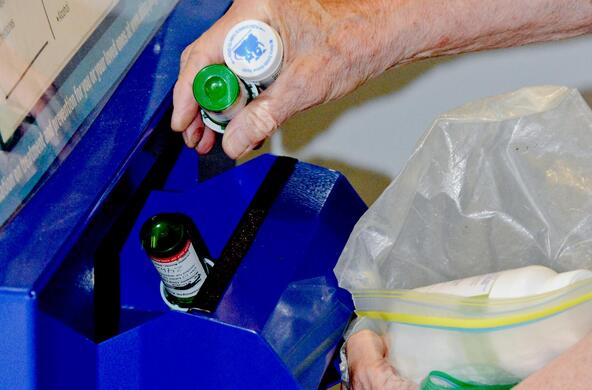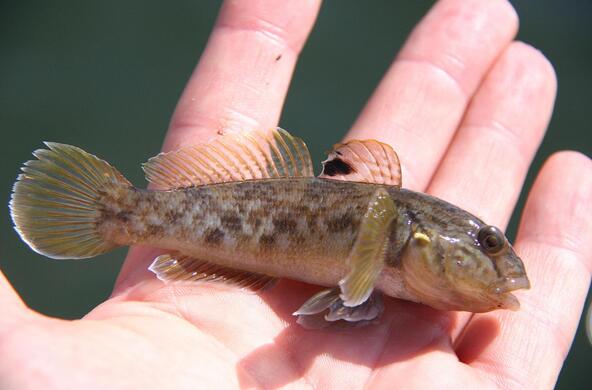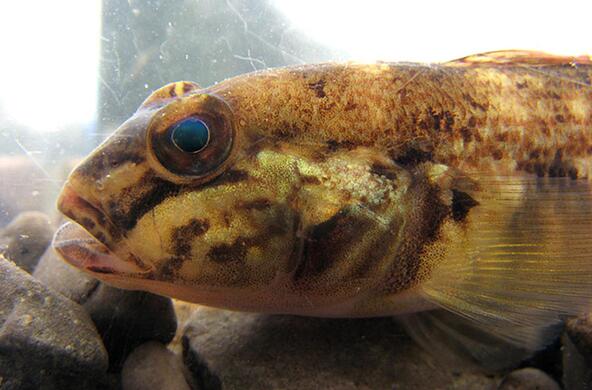Sometime in April, when the little white clusters of Dutchman’s breeches and the shadbush are in bloom, schools of shad enter the Hudson from the Atlantic Ocean and swim upriver to spawn. From mid-May to the end of June, shad mate, a dance that usually begins at dusk in shallow water. In The Founding Fish, John McPhee describes the process, as he observed it standing over a tank in a Maine hatchery: The migrating fish are milling around when the males start nosing the females, who bolt, dribbling eggs while being chased by the thrashing bucks. Eventually, the fish pair off and trailing eggs and milt, turn the water milky white. The fertilized egg masses sink to the bottom, where after a week or so they will hatch into tiny larvae, each attached to a yolk sack.
The mating ritual happens repeatedly over a month and a half. In a single spawning season, a female will release 300,000 eggs and likely more than a million over her lifetime, given that the life span of a shad is 10 years. Sometime in June, the spent fish swim back down the Hudson and north along the coast to the Bay of Fundy, the summer feeding grounds for virtually all of the shad that has spawned in rivers along the North American coast.
In the fall, the fish follow the warming currents as far south as Florida (tagged Hudson River shad have been found as far south as coastal Virginia). Meanwhile, as the water temperature cools, the three-inch-long juvenile fish have begun migrating down the Hudson. It’s a daunting gauntlet to run, filled with predatory striped bass, smallmouth bass, and white perch. As described by McPhee, the schools of small fish “dimple” the river—leap into the air and churn the water white, a phenomenon caused by the young shads’ terror-stricken attempts to move to the top of the water column in order to avoid the chomp of a smallmouth bass below. Those that make it to the ocean—that don’t get eaten and avoid getting sucked into the massive intakes of river water at the Indian Point nuclear power plant—are called “recruits,” as if they’ve signed up for the Green Berets. The fish that return three or four years hence to spawn have been likened by some observers to Olympic athletes. “They come in under a lot of stress,” says John Lipscomb, patrol boat captain for Riverkeeper. “They come into the Tappan Zee and Haverstraw having gone from breathing in salt water to fresh water, which requires changes to their gills and kidneys. The females are using lots of energy to make eggs. They’re not eating too much. It’s a heroic effort by these fish.”
The shad’s ability to adapt from saltwater to freshwater and vice versa is one their more remarkable features. A shad larva will die in salt water: It’s only when it transforms into a juvenile fish that it develops salinity tolerance. One mystery is that once the young fish have migrated into the ocean, they can’t adapt to freshwater until they make their first spawning journey several years later. Shad also have extraordinary hearing: their sensitivity to high-frequency sound—beyond that of any other fish—is believed to enable them to detect the clicks of dolphins and other marine mammals that feed on them.
A Spring Event
Historically, shad were the Hudson’s most significant fish, and up until a couple of years ago, the shad catch was a spring event. The smoked or baked delicacy, accompanied by the sauteed roe, or eggs, ideally wrapped in bacon, was served up at eponymous festivals and local tables. The fish was that rarest of things: a delicious local wild food linked to a long cultural tradition, from the urban immigrant tables of the 1880s to the drying racks of the Mahicans.
But in 2010, the Department of Environmental Conservation closed the commercial and recreational shad fisheries. The long-term restoration plan—the shad aren’t expected to recover to sustainable levels until 2050—means many of us won’t be catching or eating Hudson River shad in our lifetimes. Today, if you see a shad on someone’s table, it’s either illegal or shipped in from another state.
It was a sad occasion for the few shad left fisherman on the river. No one, however, disputes the wisdom of the DEC's decision. Populations of shad have been crashing coast-wide, according to data collected by the Atlantic States Marine Fisheries Commission. The ASMFC, a regional organization that sets regulations to protect fish inhabiting the ocean and riverine waters off the Atlantic coast, plans to institute a moratorium on all shad fishing within its jurisdiction in 2013, unless a member state can prove its fishery is sustainable. New York is obviously ahead of the game, but then, according to ASMFC's shad stock assessments, the fish in the Hudson are taking a particular hit: While the populations in other East Coast rivers have stabilized—a few have even increased slightly—in the Hudson they have been steadily declining.
Human activity over the past two centuries has pummeled the American shad. Of the original 138 distinct populations, only 68 survive, according to data compiled by marine biologists Karin Limburg and John Waldman. (Shad inhabiting West Coast rivers aren't native, but are derived from stock taken from the Hudson in the 1880s.) The damming of rivers, which blocked the fish from their spawning grounds, wiped out the shad on many rivers starting in the early and mid 19th century. Dams are ubiquitous; the only East Coast river without one is the Delaware (although the damming of its tributaries has impacted the shad). In the Hudson, shad originally traveled as far north as Glens Falls before the building of the Troy Dam. In The Riverkeepers by John Cronin and Robert K. Kennedy Jr., the legendary shad fisherman Everett Nack is quoted as saying he's observed shad "virtually bumping their heads on the federal dam."
Another blow was the building of the railroads, which destroyed much of the productive, riparian vegetation along the shoreline and also walled off the fish's access to streams. The dredging of the channel to the port of Albany was particularly devastating: The fill obliterated more than half of the marshy islands and shoals that were prime shad spawning grounds. Unfortunately, marine biologists said that destructive "hardening" of the shoreline continues, with each new riverside development nibbling away at the remaining fragments of habitat.
Net Loss
Overfishing has been a perennial problem in the 200-year history of the Hudson's shad fishery. To their detriment, shad, the largest member of the herring family, and its two cousins, the alewife and blueback herring, are remarkably easy to catch: During the spawning run, you simply set out a net—drift, anchored to the bottom, or attached to poles hammered into the river bottom. As early as the 1820s, according to McPhee in The Founding Fish, there were shortages of shad on the Hudson caused by oversized hauls of fish. By the mid 19th century, the state began regulating net lifts and stocking the river with shad from other states.
Periodically, the stock would recover—then crash again. The huge influx of immigrants stepped up demand for such an easily and cheaply procured local food: In 1895, when the first shad assessment in the Hudson was made, 5,520 nets extending from Bay Ridge to Castleton caught a total of 1,868,547 fish weighing more than 1.8 million kilograms. By 1910, the fishery had collapsed, according to an article in the Environmental History of the Hudson River (SUNY Press, 2011) by Limburg, Robert Daniels, and Robert Schmidt.
By 2009, only six fisheries were left, and the last harvest of shad in the Hudson amounted to 3,792 fish, according to the DEC. Not so many years ago, that would have been considered a modest catch for a single fisherman, let alone an entire fishery. Garry Nack, son of Everett, said when he, his brother, and a friend would go out in their boats near Catskill and pull in their 500-foot-long net, attached to 13-foot-long buoy strings, they'd catch 200 to 300 shad at a time. "I'd imagine some seasons at the peak maybe you'd catch 10,000 fish," he says. Nack recalled that he first noticed the declining numbers in 2005. Much of the shad they caught wasn't the sweet-tasting American shad, but "gizzard shad," a short, fat, weed-eating fish no one would buy.
As recently as the 1980s, the Hudson "had lots of fish," says Kathy Hattalla, one of two marine biologists at the DEC's Hudson River Fisheries unit who oversee shad. Strangely, in the mid 20th century, when the Hudson was choked with pollution, the shad fared fairly well. One factor in their favor was the timing of their migration, which enabled both the spawning fish and the young to avoid the vast, deadly pools of sewage-laden, oxygen-deprived water that formed at Albany and New York City in the summer.
Easy Prey
Water intakes by power plants have been another significant killer of fish, although there’s been some progress on this front: 10 years ago, a power plant near Albany, renamed the Bethlehem Energy Center, switched to a closed cooling system that’s drastically reduced fish mortality. However, Indian Point continues to take in over two billion gallons of river water a day, which kills larger fish by impinging them against the intake screens and sucks in millions of eggs, larvae, and small fish.
Shad are also being stressed by the numerous predators in the river. Some of these fish, such as the smallmouth and largemouth bass, were introduced, upsetting the ecology of the river, which formerly contained far fewer predators of shad and river herring. The development of the Hudson as a sports fishery has hurt the shad, according to the article by Limburg and her colleagues in the Environmental History of the Hudson River.
Marine biologists believe the two most significant causes of decline in recent years are overfishing in the ocean and the invasion of zebra mussels. Ironically, it might have been game-law restrictions on striped bass—one of the few fishes in the North Atlantic to have since made an impressive comeback—that caused many fishermen to switch to shad, depleting the numbers, Hattala says. The ASMFC noted that in 1997, 67 percent of the shad caught were by marine operations, rather than river-based fisheries. While the closing of the marine fisheries has taken off the pressure, ocean by-catch—shad that are accidentally caught in nets targeting other fish—continues to be a serious problem. Fishermen are mandated to report the by-catch, but “they probably don’t look closely at the net,” says Limburg. Unfortunately, because the number of shad is so low, “any extra deaths now are disproportionately important to the population dynamic,” she says.
Zebra mussels, a species of small mussel native to Russia, were transported to America in ship ballast and first showed up in the Hudson River in 1991. Studies by the DEC and the Cary Institute of Ecosystem Studies, based in Millbrook, a decade ago revealed that the mussels had reduced the amount of zooplankton and other tiny animals that serve as food for the juvenile fish by half; phytoplankton, which is eaten by shad larvae, was reduced by 80 percent. David Strayer, senior scientist at the Cary Institute, noted that the amount of food in shallow areas actually increased, benefiting certain fish. But fish that live in the depleted open water would be forced by the lack of food farther down river (zebra mussels only live in freshwater), where they would be more vulnerable to predators.
Strayer says that zebra mussels had completely changed the ecology of the river. “The amount of dissolved oxygen fell by 15 percent and the water got clearer by 50 percent,” he says. For unknown reasons, the adult mussels are currently dying off, resulting in areas of recovery. “There are not very many shad and herring in the river anymore, but the little ones are bigger,” he says.
He adds that invasive species pose one of the top threats to the river. “There are many more species waiting to arrive in the Hudson,” he said. An invasion of the Asian carp, which has reached waterways in Chicago, and if breaching them into the Great Lakes, would eventually enter the Hudson via the Erie Canal, would be particularly devastating, given that it is a voracious eater of plankton. “We need a coherent national policy to deal with the threat,” Strayer says.
Sea-level rise is another looming threat. Rising river waters will destroy many of the shallow areas that serve as fish nurseries, Strayer says. Letting the water migrate onto the land so that new shallow areas would be created might help mitigate the loss, but whether humans would allow this, rather than just erecting higher walls, is “not a given.”
Some marine biologists attribute the drastic decline of shad to global warming. Shifts in ocean temperatures are believed to be disrupting the food supplies of some fish. Because the shad's migration and spawning patterns are triggered by changes in water temperature—hatching of the eggs, for example, is completely dependent on certain temperatures—shifts in these temperature patterns could wreak havoc on their life cycles.
Chris Nack, son of Garry and a graduate student at SUNY College of Environmental Science and Forestry, has a fellowship with the National Estuarine Research Reserve, located at the DEC's Norrie Point facility in Staatsburgh, to study the fish nurseries in the upper Hudson. He's collecting samples of larval and juvenile shad to learn more about their habitats and diets. Now in its third year and partially funded by Riverkeeper, his research is identifying the variety of shad nursery habitats and pinpointing the most productive, which will help the DEC come up with a restoration plan. He's also found that shad larvae are eating the immature larvae of the zebra mussel—a rather startling discovery, according to Limburg.
The DEC has discovered through its sonic tagging of the fish that the spawning grounds are much smaller than was thought—basically confined to the 25-mile stretch of the upper river from the Bethlehem plant to the Troy Dam. In the past, it extended all the way to Esopus Meadows, just south of Kingston. Such shrinkage is "usually a sign that the population is shrinking. It's a warning sign," says Limburg.
Almost Gone and Soon to Be Forgotten?
Garry Nack is concerned that with the fisheries gone, shad will slip down the list of ecological priorities. He wishes the DEC would establish a shad hatchery, noting that in the 1980s, he and other fishermen were supplying a restocking program in the Susquehanna River with fertilized eggs taken from Hudson River shad.
Hattala cites several reasons why the DEC is avoiding that option. Unfortunately, the method used to obtain the eggs killed the female shad, while extracting only a small amount of the eggs that the fish would otherwise release over a lifetime, she says. And while the shad native to the Susquehanna were extinct and therefore stocking was the only option, such is not the case in the Hudson. Hattala says there may be important advantages to maintaining the genetic integrity of the Hudson River shad. Shad from different natal rivers have adapted differently; in southern rivers, for example, the females spawn only once and die.
"There is some wild spawning going on here, though it's not enough to cause the stock to increase," she says. "But I'm going to try to optimize the habitat so we give the fish the best possible chance for her eggs to survive."
The Hudson shad have a fighting chance. But since no one's catching or eating the fish, will people care? In 2025, will wildlife officials be motivated to protect a fish that has no commercial value and everyone's forgotten about?
Lipscomb at Riverkeeper doesn't believe the fish will be forgotten. He cites the example of public resistance to drilling for oil in the Arctic National Wildlife Refuge, a place few people have been, as cause for optimism. "In the past, the community of humans who cared about fish was those who harvested them for fun or business," he says. "What we're seeing now is a community of people emerging who appreciate the fish because they're a symbol of wildness. Right off Wall Street, the globe's center of economic might, you have true wildness, fish moving up in the eons-old dance with the season. I dream of a time when we recognize the value of estuaries like the Hudson and make them marine sanctuaries. The fish must come back to spawn, and they ought to be protected once they return."






